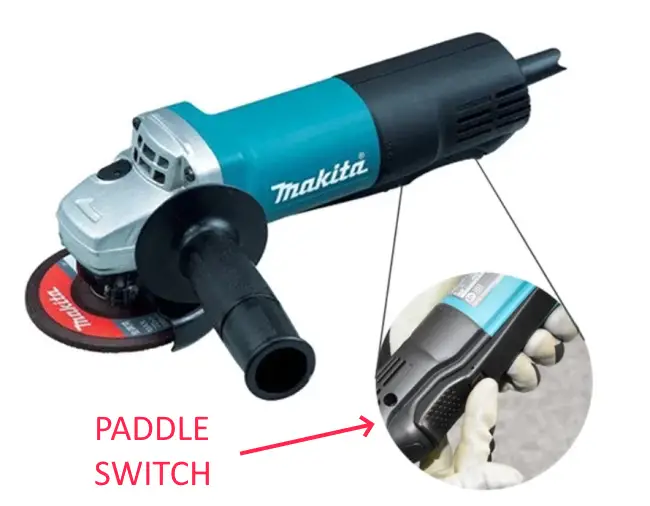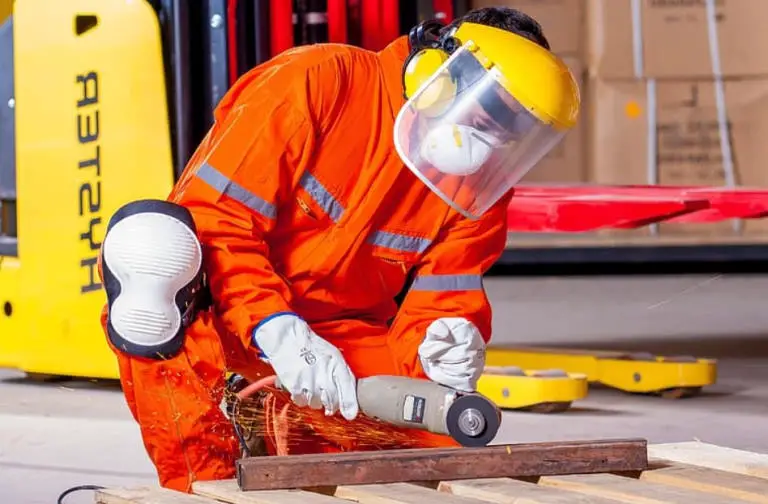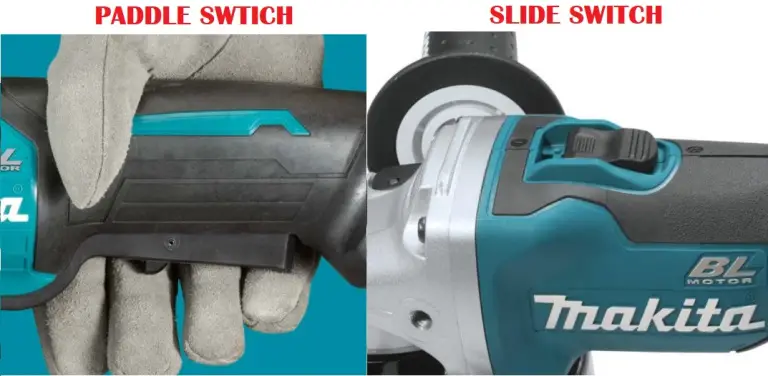Safety is essential when working with a powerful electrical tool like angle grinders. Apart from safety features, the switch type is a rising topic among professional grinders and welders. So, angle grinder paddle vs slide switch – which style is safer and convenient for you?
Let’s learn about the PROs and CONs of each switch option to pick up one that best matches your working conditions.
Contents
What Is A Slide Switch?

A slide switch (traditional on/off toggle or lock-on switch) is often placed on the top of the angle grinder. You can slide the switch to the “ON” position to turn on the grinder, and it will keep running until you slide the switch to the “OFF” position.
If you lose control of your grinder, the tool keeps running, and the disc keeps spinning, causing damages to you, the people around you, and the working surface until you turn it off.
What Is A Paddle Switch?

A paddle switch (or non-locking paddle switch) is often placed alongside your angle grinder’s handle. When you grip the handle, you also hold down the switch and keep the tool running.
If you lose control of your tool and put your hands out of it, the engine and the disc/attachment stop immediately. Thus, this upgraded switch has enhanced safety versus the traditional slide switch.
Check more: List of Angle Grinder Parts Name With Images
Angle Grinder Paddle Vs Slide Switch: Safety Issues
As safety is a rising problem in industrial settings, the paddle switch has been preferred recently over the lock-on slide switch. Although the former appeared after the latter, it is becoming more popular.
At a job site of Teton Industrial Construction Inc., 100% angle grinders are using the paddle switch due to safety reasons. Additionally, many industrial plants choose a grinder switch that doesn’t lock on for their operators. They want the switch to have a safety feature, meaning that the tool has to stop if the operator’s hand doesn’t hold the tool anymore.
Which One To Choose: Real Experience Of Users
I won’t advise you which angle grinder switch style, paddle vs slide switch, to choose or avoid as each one has its PROs and CONs. Below are the real experience sharing of some users on why they choose a switch style.
Users who choose paddle switch
- The paddle switch is easier to use and provides enhanced maneuverability and safety in high-precision applications like carving.
- The paddle switch helps prevent accidents when you lose control of your tool.
- A paddle switch is more positive to help your tool reach its maximum current, while a slide switch doesn’t.
- The paddle switch is easier to turn on & off and safer. When your tool experiences a kickback, you can just remove your hand from it, and it stops immediately.
- The paddle switch is easier to use and less likely to wear out than the slide switch when wearing gloves.
Users who choose slide switch
- A slide switch doesn’t require you to hold it down continuously. Just turn it on, and it will keep the tool running. Always have the safety guard installed adequately before using your grinder.
- One drawback of the paddle switch type is that sometimes you have to hold the tool (and the switch) in odd positions. It is also cumbersome to keep for an extended period or perform heavy grinding jobs. Hence, angle grinders with a slide switch from well-known brands like Bosch, Milwaukee, or Makita are more convenient.
- The paddle switch is difficult to operate with welding gloves.
Users who choose both two switch styles
- The lock-on slide switch is more convenient for sanding and the paddle switch is for carving.
In sum, these two switch styles don’t have differences in the overall tool’s performance. People who prioritize safety first often choose the paddle switch. For large projects or grinding projects, the slide switch surpasses the paddle one for convenience.
Safety Tips When Using Angle Grinders
No matter what type of switch you choose, consider the following safety tips when working with a versatile yet dangerous tool like an angle grinder.
Before that, you can check this best angle grinders comparison table to choose the suitable one for your job.

1. Prepare for the unexpected
Focus on your task and your tool to control it more effortlessly and lessen the chances of accidents.
2. Wear proper safety gear
Always wear appropriate safety goggles, arm protection, clothing, and hearing protection when working with angle grinders.
3. Have all safety features properly installed
The safety guard should always be on the tool between you and the disc/attachment. You can choose a grinder with an adjustable guard to work comfortably or one with a safety slip clutch/electronic clutch to prevent kickbacks.
4. Follow the instruction manual
Make sure you fully understand your tool before operating it.
5. Use two hands
Place both hands on the tool for better maneuverability, especially in high-torque situations. Grinders with a side handle help lessen vibration, reducing the risk of hand/arm vibration syndrome.
6. Choose proper disc size
The speed rating of the discs should not exceed the no-load speed of the grinder. Otherwise, using the wrong discs at high speeds increases the risk of disc shattering or exploding.
Final Words
The choice between two switch styles – angle grinder paddle vs slide switch – depends on your job requirements and your job site’s policies. And no matter which style you choose, always follow crucial safety tips to maintain your performance without causing damages or accidents. But in general, users of all levels benefit from the improved performance and safety of paddle-switch angle grinders.
